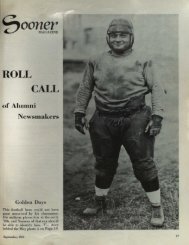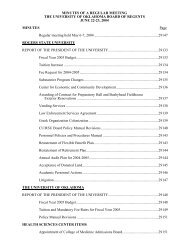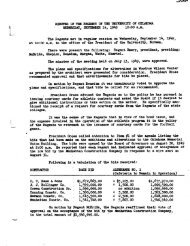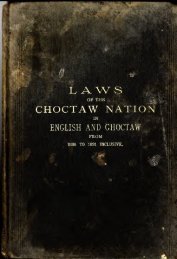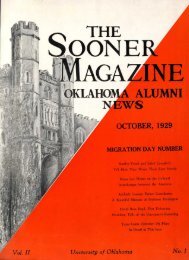Stories of Cayuga - Seneca Country. - Digital Collections - University ...
Stories of Cayuga - Seneca Country. - Digital Collections - University ...
Stories of Cayuga - Seneca Country. - Digital Collections - University ...
You also want an ePaper? Increase the reach of your titles
YUMPU automatically turns print PDFs into web optimized ePapers that Google loves.
Notice <strong>of</strong> Copyright<br />
Published and unpublished materials may be protected by Copyright Law (Title 17, U.S.<br />
Code). Any copies <strong>of</strong> published and unpublished materials provided by the Western<br />
History <strong>Collections</strong> are for research, scholarship, and study purposes only.<br />
Use <strong>of</strong> certain published materials and manuscripts is restricted by law, by reason <strong>of</strong> their<br />
origin, or by donor agreement. For the protection <strong>of</strong> its holdings, the Western History<br />
<strong>Collections</strong> also reserves the right to restrict the use <strong>of</strong> unprocessed materials, or books<br />
and documents <strong>of</strong> exceptional value and fragility. Use <strong>of</strong> any material is subject to the<br />
approval <strong>of</strong> the Curator.<br />
Citing Resources from the Western History <strong>Collections</strong><br />
For citations in published or unpublished papers, this repository should be listed as the<br />
Western History <strong>Collections</strong>, <strong>University</strong> <strong>of</strong> Oklahoma, Norman, Oklahoma.<br />
An example <strong>of</strong> a proper citation:<br />
Oklahoma Federation <strong>of</strong> Labor Collection, M452, Box 5, Folder 2. Western History<br />
<strong>Collections</strong>, <strong>University</strong> <strong>of</strong> Oklahoma, Norman, Oklahoma.
T-572-3 (Third <strong>of</strong> Four Interviews)<br />
INFORMANT: KENNETH OYLER, CAYUGA<br />
INTERVIEWED BY: J.W. TYNER<br />
INTERVIEW DATE: APRIL 13, 1970<br />
TRANSCRIBED BY: FLORA QUINATA<br />
PROOFREAD BY: NONA KERR<br />
GENERAL SUBJECT: STORIES OF CAYUGA - SENECA COUNTRY<br />
i<br />
TOPICS DISCUSSED:<br />
. /—.<br />
- BRIEF INTRODUCTION • '<br />
CEMETERIES IN THE AREA<br />
'<br />
SENACA AND WYANDOTTE TRIBES<br />
SENACA WOMEN ARE TRYING TO PRESERVE INFORMATION CONCERNING PLANTS<br />
USED FgR MEDICINE AND FOOD<br />
LOCATION OF TURKEY FORD COUNTRY - CAYUGA PEOPLE •<br />
MR. MOUSEY SPLITLOG WAS A WYANDOTTE<br />
MUDEATER FAMILY - MORE ABOUT CAYUGA TRIBE<br />
WHY THE CAYUGA PEOPLE CAME TO THIS PART OF THE COUNTRY<br />
CAYUGAS ARE TRYING TO PRESERVE THEIR LANGUAGE<br />
HAVE TRIBAL MEETINGS IN- COMMUNITY HOUSE<br />
KIND OF DRESS FOR CAYUGA PEOPLE<br />
DANCERS LIKE FEM'HERS BUT DO USE PLASTIC<br />
WENT TO CHILOCCO-BOARDING SCHOOL<br />
STUDENTS WERE PUNISHED FOR RUNNING AWAY FROM SCHOOL<br />
RECALLS MANY TEACHERS AND INCIDENTS AT SCHOOL<br />
BACKGROUND OF INFORMANT:<br />
Kenneth Oyler is a 65 year old <strong>Cayuga</strong> Indian <strong>of</strong> Commerce, Oklahomjj.<br />
He was born and raised in this area. He went several years to Chilocco<br />
and Wyandotte Schools.<br />
NOTE: The other interviews on this tape are: Joseph Rogers, Delaware<br />
Nola Jones Egnor, Cherokee<br />
Martha Redman, Delaware<br />
'- v<br />
. I
x<br />
. - % - T-572-3<br />
his life.)<br />
u<br />
CEMETERIES IN THE AREA<br />
(On Cowskin^a£rie, is it or--?)<br />
Right on the banks <strong>of</strong>--<br />
(Cowskin River)<br />
Cowskin River. Stomp grounds on the east side. Grave yard is on the west<br />
side <strong>of</strong> it.<br />
(Is there anyone living clo&e by<br />
there too?)<br />
there that knows abovftiTthose folks in<br />
'<br />
Yeah. Oh, her name's Minnie Thompson. She<br />
4 •<br />
the graveyard on the northeast corner there.<br />
lives in a house right up from<br />
(All right. I'll see if I can find her. Sometime I might need some help,<br />
you know, especially if they've got unmarked graves.)<br />
Yeah, she knows Wolf graveyard. We got another one up Council House, they<br />
call it.<br />
(That's the two mains ones down in--for the <strong>Seneca</strong>s down in there.* <strong>Cayuga</strong>s.)<br />
Yeah.<br />
(Do you remember any pf the little family cemeteries when you're traveling<br />
* •<br />
around up in there? You know there's been, a family forgotten about. I like<br />
to find those too.) . . . '<br />
No, I don't. But she might tell you.<br />
GENERAL SUBJECT: <strong>Stories</strong> <strong>of</strong> Ca'yuga - Senaca <strong>Country</strong><br />
" BRIEF INTRODUCTION -" "<br />
(April 13, 1970. I'm visiting here with Kenneth Oyler, a 65-year old <strong>Cayuga</strong><br />
<strong>of</strong> Commerce, Ottawa county, Oklahoma. Mr. Oyler talks about the*, <strong>Cayuga</strong>-<br />
Seneea country where he was born and raised and has spent nearly all <strong>of</strong><br />
-1-
i<br />
-2- T-572-3<br />
SENEGA AND WYANDOTTE TRIBES<br />
(She's been there a long time. Who is the <strong>Seneca</strong> chief now?)<br />
Vernon Crow.<br />
- i<br />
(Vernon Crow. He lives up at Wyandotte?)<br />
Miami.<br />
I<br />
(Miami.)<br />
I don't know just what his address is. You can.find it in the phone book.<br />
(Yeah. And the Wyandottes. Do they still have a chief?)<br />
Not that I know <strong>of</strong>.<br />
v<br />
(I've asked about it and no one seems to know. 'Course there's not many<br />
<strong>of</strong> the Wyandotees left up in there.)<br />
Let's see now. Seem like there was somebody. Kind <strong>of</strong> an<br />
acting business<br />
chief. Can't think <strong>of</strong> his name now. I think it's Guy Throm(?)<br />
(Hew many <strong>Seneca</strong>s are there left now?)<br />
ill , let's see. Last time I heard on rolls was 1700.<br />
(Well, you still have pretty sizeable.)-.<br />
Yeah, that's a pretty good size! That's counting all the half-breeds,<br />
quarter-breeds.<br />
SENECA WOMEN ARE TRYING TO PRESERVE INFORMATION CONCERNING PLANTS USED<br />
FOR MEDICINE AND FOOD<br />
(I was reading in', the paper here while back. There was an article about<br />
two <strong>of</strong> the <strong>Seneca</strong> women up in there. And how they were trying to preserve,<br />
oh use <strong>of</strong> the medicinal plants. Different things that the old time Indians<br />
used to use for Food, and to eat, and also things that they could--oh make<br />
baskets and things out <strong>of</strong>.. And it was real interesting.)<br />
Remember the names?<br />
(Seem like one <strong>of</strong> 'ems last name was Eagle and another one her name was--<br />
last name was Young. I don't remember their first names, though.)
3- _ , , T-572-3<br />
Mamie Young.<br />
(Yeah. Mamie Young was one <strong>of</strong> 'em.)<br />
That's my cousin. "<br />
(It is. I cut this article out so I could keep it. 'Cause it was real interesting,<br />
the things that they were talking about. I think they said, the<br />
photographer said they lived around Turkey Ford.)<br />
Yeah.<br />
LOCATION OF TURKEY FORD COUNTRY - GAYUGA ^PEOPLE<br />
(Now that Turkey Ford country where*does it relate to the highway that goes<br />
• up through there?) * . .<br />
It's <strong>of</strong>f <strong>of</strong> number 10. It's west <strong>of</strong> number 10 on the county line. Half a<br />
mile west. Now that's the old original Turkey Ford. The new Turkey Ford<br />
is east.<br />
(Oh, it's east.)<br />
Yeah, east. It's two miles east and a quarter north <strong>of</strong> number 10 on the<br />
county line. Now that's what they call the new Turkey Ford.<br />
(Well, was the old Turkey Ford was that a meeting place for the early'day<br />
<strong>Cayuga</strong>s and the <strong>Seneca</strong>s or trading post, is it?) .<br />
Ye,ah.<br />
(Well, it's been interesting to find out what a,ll they had there been at<br />
one time.)<br />
Now the main trading post over at <strong>Cayuga</strong>.<br />
'<br />
(Yeah.) ' '<br />
'<br />
That's south <strong>of</strong> the stomp ground across the lake. Kinda southeast <strong>of</strong> it.<br />
(Do you remember who run that trading post or did you ever hear who?)<br />
No. Far back as I can remember is name was Von Hotson. And then there was<br />
a Marlow took it over from him.
- -*- " . | T-572-3<br />
MR, MOUSEY SPLITLOG WAS A WYANDOTTE . ' j '<br />
(Yeah. Was that the same country that that man they QajLl Splitlog, was he<br />
in that part .<strong>of</strong> the country?) •<br />
He's a Wyandotte.<br />
(He was Wyandotte.)<br />
Yeah, but he was our chief one time. I don't know how he got to be chief.<br />
(No, I don 't know either.)<br />
Now his father, his boy, I mean, works there at Wyandotte Indian<br />
school.<br />
(Well.)<br />
His name, they call him Mousey. Mousey Splitlog. He knows all about that.<br />
I believe they're Wyandottes'. .<br />
(Wyandotte.)<br />
Yeah. * ' • .<br />
MUDEATER FAMILY - MORE ABOUT CAYUGA TRIBE<br />
(And there was several <strong>of</strong> that Mudeater family.)<br />
The only I know was 'the old man. They call him Alfred Mudeater.<br />
(Yeah. That would be in the same bunch. Do the <strong>Seneca</strong>s still have their<br />
summer meetings at the stomp grounds?)<br />
Yeah. Yeah, they'ljL start having 'em there now. They was having 'em over<br />
at the Council house durirfg the winter. They have it the first Tuesday<br />
in every month, there's lot <strong>of</strong> different tribes. Some <strong>of</strong> 'em talk Indian.<br />
You can see and hear where the different tribes can understand one another.<br />
But my tribe I've never run across different tribe <strong>of</strong> Indian that talks<br />
anything like my tribe.<br />
• *<br />
(Well.)<br />
<strong>Cayuga</strong> language. . . .<br />
(Yeah.)
* • *<br />
c<br />
-5- T-572-3<br />
* {<br />
\<br />
I don't know why they keep calling us <strong>Seneca</strong>s. We're not <strong>Seneca</strong>s. We're<br />
<strong>Cayuga</strong>s.<br />
(<strong>Cayuga</strong>s.) ^ .<br />
Yeah. . . -.-...•<br />
(Where did they originally come from Mr. Oyler?)<br />
,New- YorV.<br />
x<br />
.<br />
(New York.) - ' -"- ;<br />
Cnaada and New York. • • ,' ,"*<br />
(Canada. Well, that would be one r <strong>of</strong> the reasons then that your language<br />
is so different. Did you ever hear what part <strong>of</strong> Canada and New York that<br />
your reservation or land was?)<br />
Seem to me like fehey used to talk about Caldonia./<br />
WHY THE CAYUGA PEOPLE COME TO THIS PART OF THE COUNTRY<br />
(Caldonia? Were they moved down here into this country or did they come<br />
down on their own?) ^ ''<br />
Well, now, they way I understood, they came down on their own. And see, the<br />
New York state paid 'em fifteen or eighteen hundred dollars a year. Now<br />
that's as long as green grass grows and water flows.<br />
(Yes.)<br />
And they come down here, they didn't have no land or nothing. The <strong>Seneca</strong>s<br />
had that land. And they giye the <strong>Seneca</strong>s right to their loan.-<br />
(Well.)<br />
Share it with 'em for the land. They just bought themselves in over here.<br />
That's the way I understand it.<br />
(Yeah. I'never did know what that arrangement was.)<br />
I can't even understand <strong>Seneca</strong>s.
. . ' -6- T-572-3<br />
CAYUGAS'ARE TRYING ,T0 PRESERVE THEIR LANGUAGE<br />
(Are the <strong>Cayuga</strong>s preserving their language? A*"e there enough <strong>of</strong> them--)<br />
Yeah, they're trying to do it now. They started it up here not long—about<br />
six or eight months ago. Yeah, there's a lady down there that holds classes<br />
once a week.<br />
* (Good.) ~ " ' .<br />
She's'been wanting me to come down there and learn the language. I used<br />
to could talk it good when I was a kid. But I've forgotten it.<br />
(Of the old settlers up ther§, old families still living in that Gayuga<br />
area, who are some <strong>of</strong> the oldes-trones' still living? That would represent<br />
their families?) • •<br />
Well, I would say Minnie Thompson is' the oldest one that I know <strong>of</strong>. And<br />
Mamie Long.<br />
(Yeah. She's another old one too.) • '<br />
Yeah, she's getting old. I've gotten her picture. And my sister Edna Harris,<br />
her name is,.- She's in a rest home. She can't even<br />
talk no more. That's<br />
' about all the old ones, I know.<br />
(No men that you can think <strong>of</strong> still living up in there <strong>of</strong> the older ones.)<br />
Oliver Charloe (?) is about the oldest man I know <strong>of</strong>. He's not very old.<br />
About 67. He lives out there by Dutch White.<br />
HAVE TRIBAL MEETINGS IN COMMUNITY HOUSE<br />
(They still have, I mean, they have lots <strong>of</strong> meetings there at the Community<br />
House, at the Council House rather. Every now and then I read something<br />
about they have a meeting up there.)<br />
They have one<br />
every month. Tribal meeting."<br />
(Yeah, I think that's good that they-can get together, even if it's just<br />
social work.)
-7- . T-572-3<br />
• • - i '<br />
.(Of course they have business work too, I know. More and more tribes are<br />
doing that in this time.) .<br />
My tribe was about the first one to adopt that there Wheeler-Howard ,bill.<br />
They been following it ever since they adopted it.<br />
(Well, there!s lot to that council work and being a council man too. Takes<br />
a lot <strong>of</strong> time. {Sentence not clear.) I just wondered if you've ever heard.)<br />
No, I never heard about it. ' *<br />
KIND OF DRESS FOR CAYUGA PEOPLE<br />
(The <strong>Cayuga</strong>s did they go in for feathers and that kind?)<br />
No. ' ' ' '<br />
(Silverwork and that kind <strong>of</strong>--)<br />
Fluffy dresses is all they wore. And blouses. ,<br />
(Yeah. You know it's surprising in a way a lot <strong>of</strong> the Indian tribes did<br />
not go for jewelry and feathers. In some <strong>of</strong> the old drawing and pictures<br />
<strong>of</strong> the 5 all those Indians in .the north and northeast and very few "<strong>of</strong> 'em<br />
had decorations on. Just plai'n buckskin and maybe cloth sometime.)<br />
I understand the Sioux was about the first ones that started the feather<br />
dance. , '<br />
v *<br />
(Yeah, seem like the eagle feathers and hawk feathers were the most important<br />
used. But now they can't get eagle feathers they tell me.)<br />
Yeah, it's against the law to kill an eagle.<br />
('Course now on deer tails'. They still use lots <strong>of</strong> deer tails.)<br />
They're<br />
getting so they can make those head roaches out <strong>of</strong> plastic.<br />
(Is that right?)<br />
Yeah. They're pretty too.<br />
DANCERS LIKE FEATHERS BUT DO USE PLASTIC<br />
(Really getting modern. Yeah, I notice some <strong>of</strong> those dancers. They Look like,
- -8- .T-572-3<br />
they don't look like deer tails. You know how they spread it and then fold<br />
it back. They look like might be plastic. But they're real pretty.)'<br />
Yeah, you know long time ago when the Indian used to use porcup'ine roaches.<br />
(Well..) • -<br />
I notice here lately. I ,been going to these war dances looking at their<br />
costumes. I ask one boy, I said, "What's your Jroach made out <strong>of</strong>?" He said,<br />
"Plastic." Boy it was really pretty. Had a lot <strong>of</strong> color to it, you know.<br />
(Well, that would be pretty, wouldn't it.)<br />
Yeah..<br />
•<br />
(Have a' costume made out <strong>of</strong> scissor t.ail feathers.)<br />
Pretty delicate feather though.<br />
(Oh yes,<br />
that's dedicate. See, you only get about two or three tail feathers<br />
out <strong>of</strong> each bird, don't you?)<br />
You get four.<br />
(Porur)<br />
Four long ones.<br />
(Yes sir, ,that would really be pretty.)<br />
That's against the law to kill them too.<br />
(Yeah, they're protected. That's .the state bird ncwtoo,isn't it?)<br />
Yeah, Kinda got waves in it.<br />
s<br />
(Yeah.)<br />
The rest <strong>of</strong> them are just straight. Straight feather.<br />
(Yeah, I've never seen one.)<br />
Third voice: I've seen lots <strong>of</strong> them. Boy! They sure pretty. Lots <strong>of</strong> 'em<br />
up in the Wyandotte country.^<br />
WENT TO CHILOCCO BOARDING SCHOOL<br />
(—Wyandotte country. Well that wasn't very thickly settled in there, was it?)
-9- ' T-572-3<br />
\<br />
Yeah, that's whereN^ first went to school. In 1914.<br />
—(1914. Were" there any\ther schools J.n that area then?)<br />
• '<br />
No. That was the s<br />
/ \<br />
only one around there. Grove was the closest place.<br />
(Yeah.) \ '<br />
\<br />
See, we lived out about seven mi\es northeast <strong>of</strong> Grove.<br />
(Yeah.)<br />
Two miles west <strong>of</strong> Beaver.<br />
(Well, was that Wyandotte Indian school going in those early days?)<br />
Yeah, it was going. I didn't go there till ar^er--I was about twenty-two<br />
or three years old. I went to Chilocco first, tome back and went to*Wyandotte.<br />
(What year did you go to Chilocco?*) \<br />
'25. (1925) - \<br />
\<br />
('25.) • \<br />
\<br />
(Words not clear)-- Albert King and lot <strong>of</strong> them Kings.<br />
STUDENTS WERE PUNISHED FOR RUNNING AWAY FROM SCHOOL<br />
(Boy there's lot <strong>of</strong> 'em run <strong>of</strong>f in those early days from Chilocco,.)<br />
Yeah. \. ' ' / \<br />
(Well, I know how they felt though. Boy, I got homesick too. They had\a<br />
price on their head.) ' \<br />
Yeah, section, crew if they catch you, they get two dollars a head.<br />
(Yeah. Just like hunting convicts. Any Indian, and if he went long ways<br />
well they got more for bringing him back.)<br />
, . r<br />
Yeah. . . < •<br />
(I know down around New Kirk and Ponca City those folks down there they<br />
was always hunting for runaway Indian students. Sometimes they get twelve<br />
or fifteen dollars for one <strong>of</strong> 'em. 1 They get more for the<br />
girls they said.<br />
I don't know how much. But it made<br />
person feel like he was, I don't know<br />
What.)
• ' -10- T-572-3<br />
Like hunted coyote—.<br />
(Yeah, hunted animal or something. You remember the old jail up there?<br />
They used to bring 'em in and throw 'em in that old jail. It was more lil/e<br />
a military prison than it was a school. Old uniforms, Craig rifles.)<br />
Yeah, we used to have to drill with rifles.<br />
RECALLS MANY TEACHERS AND INCIDENTS AT SCHOOL<br />
(Lot <strong>of</strong> things to remember about that place. Never forget that hard tack.)<br />
Think about it now. That was a good school.<br />
(Yeah, when I think about it now, it was a good school. Lot <strong>of</strong> things we<br />
didrf\t like.) . 4<br />
i -A<br />
Had a lpt <strong>of</strong> good land there.<br />
(They had a lot <strong>of</strong> good land, boy. What was the name <strong>of</strong> that creek that<br />
run down through<br />
g<br />
there? Do you remember?)<br />
\<br />
I forgot,the name.<strong>of</strong> that creek and I was always parching corn down there.<br />
\<br />
(Was that the one bhey call Waukarush.a?)<br />
I don't remember what\they call it. What they did call it.<br />
(Yeah, I remember they used to have--I know these Creek Indian boys they'd<br />
stomp' dance every night. Parch corn. I remember Jesse James. He was always<br />
leading a stomp dance. He was in my class.)<br />
\ Yeah, I remember Jesse, (Word not clear)—up there the time he went.<br />
' ' ' \ ' ^<br />
(Yeah) . ' \<br />
Paul Glazer(?), too. ( \<br />
(Yeah, in later years he was a farm boy back then. Paul Glazer was the<br />
athletic man.)<br />
x<br />
Yeah.<br />
(And Densmore<br />
v<br />
was the poultry man. And McDonald he was the--No y McDowell<br />
he was carpenter instructor.)<br />
-\
-11- T-572-3<br />
V<br />
Vann was the band teacher.<br />
(Vann was the band. I'm trying to remember the man--the one that had charge<br />
<strong>of</strong> the stone mason. And I can't think who that was. He was a little, bitty<br />
short fella.)<br />
He was Sac and Fox.<br />
(I believe he was. I may be wrong.)<br />
v<br />
Yeah, .there's some Franklins. Sac and Fox.<br />
(Spae <strong>of</strong> those boys turned out to be real artist. Well, Acee Blue Eagle.<br />
You know, we called him Elliot Mclntosh when he was up there. Now he's another<br />
one<br />
that turned out to be a good artist. In fact he was quite famous when<br />
he died.)<br />
Major up there's name was Lannahan.<br />
(Yeah.)<br />
I was in company A.<br />
(Yeah.)<br />
I was the smallest one in company A.<br />
^^<br />
(Well,let's see Nelson Rowe. He was kinda assistant boy's advisor. I don't<br />
remember whether he was home two or home one. But he stayed there ti11 he,<br />
retired though.) ' \<br />
The farm boss was the—Later he become superintendent up there.<br />
orrall.)<br />
\<br />
Corrall, yeah.<br />
(That'\ who I was trying to think <strong>of</strong>. And that small boys'<br />
matron, Rose<br />
\<br />
\<br />
Daughtery v . What<br />
\ Shawnee.<br />
tribe was she?)<br />
Shawnee.)<br />
Ye^ah.
-12- - T-572-3<br />
(Oh another man I was trying to think' <strong>of</strong>. Harry S. Keller. I thought that<br />
was the meanest man in the world when I first went there. Do you remember<br />
him? Big boys home one boys' advisor. Tall, slim, army man.)<br />
Yeah. ' '<br />
(He sure didn't have many friends there at one time. Then some <strong>of</strong> them big<br />
old boys now they'd tangle with him. I can't remember which one it was.<br />
Remember the jailer they had*. The one they call the "big man from the south<br />
with gold in his mouth" Jackson Issacc, Choctaw from Mississippi. Big, tall<br />
dark-complexion.) ><br />
I remember that name, but I don't hardly remember him.<br />
(He was the jailer there. I remember that.').<br />
I remember lot <strong>of</strong> names, but don't remember how they looked, you know.<br />
I learn 'em by roll call in the morning.<br />
(Yeah.)<br />
(End <strong>of</strong> Interview.)
April 13, 1970<br />
; •<br />
Index side B, recording time 22 min.j interview ti,me one hour. .<br />
(first hoIf <strong>of</strong> tape.)<br />
Informant: Kenneth Oyler, 65-year-old <strong>Cayuga</strong>,<br />
Commerce, Ottawa County, Okla.<br />
Subject:<br />
<strong>Cayuga</strong>-<strong>Seneca</strong> country.<br />
Of a^l Indian tribes in Oklahoma the <strong>Cayuga</strong> probably number fever than<br />
any other, except for the Hea, Piankashaw and Kaskaskia. A few members<br />
<strong>of</strong> these disappearing tribesmen, are still to oe found. Mr. Oyler is<br />
very proud and lets 'it be known that 'he is a <strong>Cayuga</strong>. *ir. Oyler wss'<br />
born and raised on the Cowskin iiver in northern Delaware County and<br />
has spent all his life in northeast Oklahoma, and at this visit he toHs<br />
some things about his people.<br />
The history <strong>of</strong> t l .e Coyugi Indians begins in ^ro •r.rly recordings <strong>of</strong> the<br />
native people <strong>of</strong> North Ame'rica. Their original home was in New York State,<br />
and were <strong>of</strong> the Iroquoi Confederacy as one <strong>of</strong> vthsfive Nations. In the ^<br />
1700s a large part <strong>of</strong> the tribe left New York antfwent into Canada, while<br />
small bands went into Ohio to join wi'th o^her tribes <strong>of</strong> the Iroquoian<br />
linguistic family, that became known as <strong>Seneca</strong>s, while at> the same time<br />
each tribe recognized its individual origin and identity. The prime<br />
reason for'the several bands <strong>of</strong> Indians living together was for protection<br />
and strength thru unity. - Early historical accounts tell that the <strong>Seneca</strong>s<br />
(which were made up <strong>of</strong> bands from the Erie, Conestoga, Oneida, Onondaga',<br />
Mohawk, and <strong>Cayuga</strong>) came into Indian Territory as early as 1P32. Since<br />
that time <strong>Cayuga</strong>s have been living in northeast Oklahoma, and for tribal<br />
•business natters and recognization their naie is incorporated now as the<br />
<strong>Seneca</strong>-<strong>Cayuga</strong> Tribe.<br />
Mr, Oyler's original home was in what is known as Bassett's Grove area<br />
on the Cowskin .tiv4r in the extreme northern part <strong>of</strong> Delaware. Bassett's<br />
Grove is the location/<strong>of</strong> their old meeting place, their church, stomp<br />
grounds, ani the homes <strong>of</strong> many Cayug
Kenneth Oyler -2- . '**'-/<br />
J<br />
Host <strong>of</strong> the <strong>Seneca</strong>-Cavuga live, in Ottawa County and >'r. Oyler says that<br />
there about l?00 enrolled under the arly day Indians <strong>of</strong> that<br />
area was at <strong>Cayuga</strong> on the south ^ide <strong>of</strong> Cowskin aiver. At one time<br />
the trading post at Cayuja was operated by Grover Splitlo^. The oost nc<br />
longer exists, but the beautiful stone church Yuilt $^re stands cas a<br />
memorial to that prominent "Indian-, "hen Mr. Oylor remembers the Cayu^a<br />
trading "^ost it '-"as operated by r man name 1 - Hei^e, --nd l.^t«r y c man<br />
na^ad Karlow.<br />
Kr. OVIT tells that the Cayu^a lanjuca~e i? ?til] preserved ${i spoken<br />
by several <strong>of</strong> his tribe. He .says the lan^u-^o is very easy ar compared<br />
to many <strong>of</strong> the Indian dialects, and he ha?' n^ver iieard jnot'ror lanjT^e<br />
th"t sounds li'^ the Cayu~a. - ^<br />
He tells that tro. Cnyuav.s to his knowledge n r ve :\(*v-?r ~one i*a fc much<br />
color, jovelry and feathers in^th-ir dr-isc. 2ec i :\:J quill work h^a -con<br />
about the limit ^? any adornment tc their mt-ive drps?, ho::e'-rr, buckskin<br />
has b-°en used to a tjreit oxt^at. The li r its th #i t thr vhitcman rill jo to<br />
t\°de the Indian out <strong>of</strong> liii' money knows no -?"A. r .n; no^; Mr. Qyler s iys that<br />
the Indians are sold elastic deer tails, dyed t M r'




